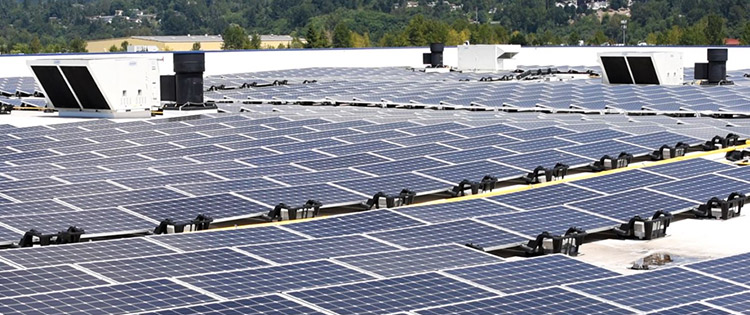
Have questions or need help with the Distributed Renewables program?
We're here to help!
Distributed Renewables
To facilitate our commitment to a clean energy future, PSE offers the Distributed Renewables program (sometimes referred to as Distributed Generation (DG) or Distributed Energy Resources (DERs)). Working with developers and our customers to develop a cleaner more resilient power grid, we are meeting both our region’s needs and PSE’s renewable energy goals.
Our aim is to support the development of customer-owned renewable energy projects that generate up to 5 megawatts interconnecting to the PSE electrical distribution grid.
Current federal and state laws require the interconnection customer to be responsible for all costs related to interconnecting generation and energy storage (battery) systems to PSE's power grid. PSE has prepared an extensive technical requirements document (with examples) to assist the customer with navigating the complexities of interconnecting DERs and ensuring a modern state of the art grid that is safe and reliable for all customers.
In addition, PSE offers Rate Schedule 91, a standard offer Power Purchase Agreement for Qualifying Facilities up to 5 megawatts. (Refer to Resource Links, below.)
PSE also offers Rate Schedule 667 and Schedule 686 for customers interconnecting solar generators up to 1 megawatt (1,000 kilowatts).
- Solar Energy Credit (Schedule 667) Earn financial credits for each kilowatt-hour generated and exported to the grid
- Multi-Occupant Solar (Schedule 686) Share financial credits with designated tenants for each kilowatt-hour generated and exported
For Qualifying Facility Transmission Interconnection Service (QFTIS), PSE offers Schedule 153.
A customer/developer team including project management and engineering professionals with experience in utility grade generator interconnection is required for these types of projects.
Apply now
Types of systems
When a generator or energy storage system will operate in parallel with PSE’s distribution system, the interconnection is governed by WA State Jurisdiction, PSE Electric Generation Schedule 152 which provides for three types of interconnection:
- Export Power Only. A site with no customer load (beyond small draw for equipment operation) where the entire output is metered and connected to the distribution system.
- Import and Export Power. A site with a significant load, but less than the output capacity of the generation. Generated power will offset imported power from PSE and generation in excess of the site load will be exported to PSE.
- On-site Only Power. A site where generation is less than the lowest existing customer load and there is no intention to export power to PSE. Power export may be limited by PSE specified protection devices in this case.
Qualifying technologies
New and existing business and residential customers looking to take greater control of their electricity usage are encouraged to apply when installing qualifying customer-sited, renewable technology including:
Business Customers
- Grid scale solar photovoltaic (PV) including community solar projects
- Energy Storage/Battery technologies
- Combined Heat and Power (CHP) projects
- Biogas and Methane: Dairy Digesters and Landfill gas projects
- Hydroelectric turbine projects
- Grid scale wind projects
- Fuel Cell technologies
- Supercritical CO2 or Hydrogen turbine technologies
For Residential Customers
- Storage-only batteries operating in parallel with PSE’s grid
Steps to apply for interconnection
The interconnection process, from initial application submittal to final approval to operate, can take 6 to 24 months to complete, depending on project complexity. External factors, such as long lead times for equipment or permitting, may impact construction schedules.
To get started, please review the following steps:
- Review the following documents (available below):
- Prepare the following items:
- A project site plan
- An 8760 generation projection
- An electrical schematic which meets the requirements listed in the Technical Requirements in PSE-TC-160.70
- Visit our online portal to complete and submit a signed interconnection application.
- Process an ACH or Wire Transfer application fee.
PSE will review your application for completeness. Once complete, the application will proceed to engineering studies. We look forward to working with you through the steps in the development of your project.
Engineering studies may identify required distribution system upgrades, which the interconnection customer is responsible for, in order to interconnect to PSE.
If there is no existing power at the proposed site, a Non-Residential Service application for permanent service must be completed.
- This application should be filled out by the installer and include the electrical design
- Include the both the both the email of the customer responsible for construction billing and the distributedrenewables@pse.com email in the “Construction charges contact email”
- Input applicable project notes in the “Additional Project Information” section
For more information or assistance with the Distributed Renewables interconnection application process, email distributedrenewables@pse.com. Enter project name in subject field of all email with PSE.
-
Learn more
Schedule 152 Generator interconnection
- General overview of Schedule 152 interconnection process
- Technical Interconnection and Interoperability Requirements PSE-TC-160.70
- State Jurisdiction Electric Generation Schedule 152 (Interconnection)
- Paper Application for Tier 2 or 3 Generator Interconnections
- Paper Application for Tier 1 Generator Interconnections
- FERC Qualifying Facility Information (for projects with a net generating capacity greater than 1000kW)
- PSE New Commercial Electric Service Application (for projects with no existing site service or with modifications to existing service)
- PSE Electric Service Handbook (for Meter Placement)
Power purchase agreements
- Schedule 91 – Attachment A Power Purchase Agreement with Existing Qualifying Facilities
- Schedule 91 – Attachment B Power Purchase Agreement with New Qualifying Facilities
- Schedule 91 – Attachment C Power Purchase Agreement with Non-RCW 80.80.040 Compliant Qualifying Facilities
- Schedule 91 – Purchases from Qualifying Facilities of Five Megawatts or less
- Schedule 91 – Pricing Model A – Distribution System
- Schedule 91 – Pricing Model B – Transmission System








